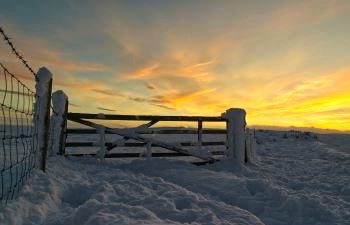What the winter solstice is really about
Posted on behalf of: Communications
Last updated: Thursday, 19 December 2024



For thousands of years, the winter solstice – this year on 21 December – has symbolised rebirth and renewal. The word “solstice” is derived from the Latin words “sol” (sun) and “sistere” (to stand) and literally means “The day the Sun stays still”. But what else do we know about the effects of the shortest day on ourselves and our planet?
Imogen Harris and Jacqui Bealing asked Sussex academics across the disciplines to reveal their knowledge.
Midwinter cultural traditions
Professor Jon Mitchell, Professor of Social Anthropology: “The winter solstice marks the point at which the shortening days end, and light begins to grow. As such, traditions and folklore surrounding the solstice often revolve around themes of renewal and rebirth. In woodland folklore, the balance of light and dark is sustained through an eternal battle between two Kings – of Holly and Oak. The Oak King reigns in the light-filled summer but is usurped and vanquished by the Holly King in the darkening days of autumn.
“Winter solstice marks his rebirth, and the promised return of summer’s light. Light (and warmth) also come from the Yule log, traditionally lit on the eve of winter solstice, and burned for 12 days. The wood of choice was often the slow-burning root of the Ivy – a species symbolising friendship and flexibility in contrast to the Holly’s strength.
“Echoes of these traditions persist in winter songs and Christmas card imagery – but also more explicitly through the work of storytellers and heritage animators, not least those associated with the South Downs National Park.”
The science of solstices
Dr Darren Baskill, Lecturer in Physics and Astronomy: “The winter solstice, the day of the year with the shortest daytime and longest night, occurs in the Northern Hemisphere at 9.19am on 21 December 2024. This is the moment when the Earth’s North Pole points away from the Sun.
“The Earth is tilted (at 23.5 degrees) such that the North Pole always points towards the star Polaris. On the summer solstice, the North Pole points over the Sun. Six months later, on the winter solstice, when the Earth has moved to the other side of the solar system, the North Pole is pointing away from the Sun. Here at the University of Sussex, the Sun is above the horizon on that day for just seven hours and 57 minutes – but that does give us six minutes more daylight than London!
“The earliest sunset this year was on 12 December, and the latest sunrise on the 30 December. This variation is due to the tilt of the Earth's rotational axis and the Earth's elliptical (not circular) orbit around the sun.
“For stargazers like me, a clear midwinter sky is an absolute gift. The Geminid meteor shower – the best of the year - is visible until 20 December, and the constellation Orion is looking great at this time of the year too.”
How less daylight affects our bodies
Dr Maria Hadjimarkou, Lecturer in Psychology: “Daylight has a profound effect on our mood, our sleep and our sense of wellbeing – which is why we especially notice its absence in midwinter.
“Light received through the retina sends projections to a region of our brain called the suprachiasmatic nucleus (SCN). The SCN is our biological clock, which uses this information about light to orchestrate numerous activities throughout our brain and body over the 24-hour cycle. In countries with greater disparities between the seasons, shortened daylight has been identified as the cause of Seasonal Affective Disorder, characterised by an increase in sleepiness and fatigue and a craving for carbohydrates. The condition is treated by exposure to bright light daily.
“It is not clear how changes in light can lead to mood changes, but one possible reason may be the dysregulation of melatonin, which is normally secreted in the evening to help us fall asleep. During the short winter days, there is an overproduction of melatonin, which leads to fatigue the next day.
“Artificial light is often not enough to stimulate the neurons in our SCN to signal the presence of daytime. So, as we approach the winter solstice and the days begin to shrink, it is good to spend time outdoors in the morning and in a well-lit environment during the day, whereas in the evening, we should dim the lights so that we can transition to sleep later at night.”
Why plants go slow in winter
Dr Maria Clara Castellanos, Senior Lecturer, Ecology and Evolution: “As an evolutionary biologist, I am fascinated by plant adaptations through changing seasons. Plants in temperate regions of the world spend months preparing for the winter solstice and the weeks that follow, many shedding their leaves or generally becoming inactive.
“The short, cold days mean they need to slow down photosynthesis to save energy and avoid frost damage. But the solstice is a turning point in that process: the lengthening of the days that follow works as a “biological clock” that, along with temperature, signals to the plants to get ready for the spring.
“As global warming renders temperature as an unreliable cue, the solstice remains a crucial signal. It works so well, that even in tropical regions, where the shortest day of the year is only a few minutes shorter than the longest, plants use day length to time their flowering!”

